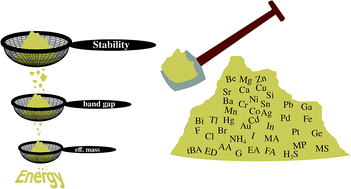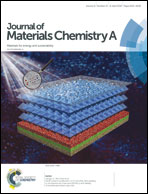Stable hybrid organic–inorganic halide perovskites for photovoltaics from ab initio high-throughput calculations†
Abstract
Hybrid perovskites, such as methylammonium lead iodide, have revolutionized research on solar cells in the past few years. Well known instability and toxicity issues restrain however the large-scale application of these perovskites in commercial photovoltaic technology. It is therefore the most urgent task to find a way to chemically stabilize these and other lead-free perovskites, preserving at the same time their excellent absorption and charge-transport properties. The obvious route to follow is chemical substitution. In this work we screen the periodic table of elements for hybrid organic–inorganic halide perovskites, using high-throughput density-functional theory calculations. We consider compounds with the composition A+B2+X3−, where A is a molecular organic cation, X is a halogen, and B is a divalent element. For the molecular cation, we vary the molecule size from sulfonium (H3S, very small) to tert-butylammonium (C4NH12, very large). All thermodynamically stable hybrid perovskites are then further characterized by calculating their band gaps and effective masses, to identify the most promising candidates for further experimental and theoretical characterization. We find that the substitution of the organic molecule is the most promising way to enhance thermodynamic stability, while there is no optimal replacement for lead or Sn, unless one considers partial substitution or alloying.



 Please wait while we load your content...
Please wait while we load your content...